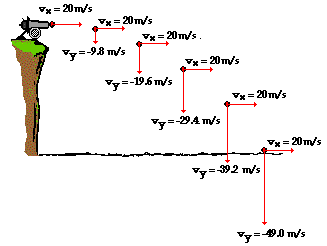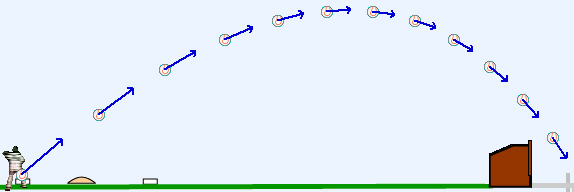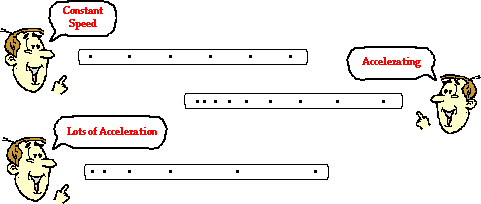Getting closer to the fall exams, I realized that this blog reflection has to be more than what I've done in the past. Hopefully, it does not get too boring :)
In this unit I learned about Newton's Third Law, Vectors, Tension, Force of Gravity, Tides, The relationship between Impulse and Momentum, the Conservation of Momentum...wow! That's a lot of topics I will be covering on this post, stick around! I'll take each one by one.
Newton's Third Law
Newton's Third Law explains that with every action there is an equal and opposite reaction. Newton is trying to say that all objects have a relationship/interaction. These are called action/reaction pairs.
For example, take an apple sitting on a table:
The apple is pulling the Earth up, while the Earth pulls the apple down. But if you want to get into logistics with the table included, there is a whole other relationship between either the apple and table or the earth and table.
In order to create action/reaction pairs, there are three rules that must always be followed
- The verb must always remain the same (pulls/pulls, push/push, hit/hit)
- The direction that was stated first, must be opposite at the end (up/down, left/right)
- The object must stay the same and then switch
Next, if someone were to ask the question "Which vehicle has the bigger force? A truck or a car?" I am assuming your immediate answer would be the truck just because it is bigger. Well this mentality is incorrect. As learned previously in Newton's Second Law, Force equals mass times acceleration.

This means that if there is a bigger mass, there will be a smaller acceleration and vice versa, if there is a larger acceleration, there will be a smaller mass. This is why the answer to the question stated above, is that they will have an equal force. WOW!
Next, I learned about an essential question: Why does a horse pull a buggy?
 |
| Action/Reaction Pairs. Created on Paint -JL |
So you might see a bunch of paired arrows in different colors. Well by the end, you should be able to know what descriptions go with each pair.
Green Arrows: The force is pulling the buggy forward an the buggy is pulling the horse backward
Blue Arrows: The horse pushes the ground backwards and the ground pushes the horse forward
Red Arrows: The buggy pushes the Earth forward and the Earth pushes the buggy backward
Realize how I used the rules that I talked about earlier to make these action/reaction pairs.
A horse pulls a buggy with the same force the buggy pulls the horse because of Newton's 3rd Law that states with every action, there is an equal and opposite reaction. The reason the horse is able to pull the buggy is because it is able to push the ground harder.
Something you must remember in all of these instances that have a relationship like this is that whoever can push the ground harder will move in the direction they wish to go. This is because Earth pulls everything downward. Another example of a relationship like this would be a tug of war.
Vectors
Vectors are a little hard to explain but they occur when two forces are perpendicular and when we are trying to find out in what direction an object or a person will go.
| Showing two perpendicular forces |
Vectors show magnitude and direction.
In order to create the middle arrow that will show you in which direction the object will go, you must draw a parallelogram like so:
 |
| Created on Paint |
The purple arrow represents the direction that the object will end up going in.
This led into the next essential question: Why does a block slide down a ramp?
| Taken from my notes -JL |
First we must know the different forces the box has on a ramp.
- Support force: a force that is always perpendicular to the surface
- Fweight/gravity which is pulling box down onto ramp
- It has a fnet which is sliding the box down the ramp
Tension
| Disregard Numbers |
Tension is the pulling force exerted by a string, cable, chain, or similar solid object on another object (Wikipedia). Tension shows how much force is being exerted on each side of a string and by calculating it, we know which side is most likely to break.
To calculate tension:
- Draw an fweight
- Draw an fnet (which is equal and opposite to fweight)
- Draw a parallel line to each tension line
- Draw tension vectors
Force of Gravity
In this section of the unit, I learned that everything with mass attracts all other thing with mass.
I learned that force depends on 2 things:
- Mass of objects
- Distance between two objects
Also, I learned that force is inversely proportional to force because of the inverse square law which is:
F~1/d^2
If you were to use this equation for any number, for example 1, this is what it would look like:
 |
| Problem for Inverse Square Law. Created on Paint |
Subsequently, we learned about solving for gravitational force with the formula being:
I learned that G=6.67*10^-11 Nm^2/Kg^2. This is a super small number. This formula is universally accepted as the gravitational formula for force.
Some other key points that may be important are:
- you weigh less on Mt. Everest than at sea level because you are closer to the Earth's core.
- in case you don't know how to multiply numbers with powers of 10, here are some suggestions:
- separate the whole numbers from the "10 to the whatever powers"
- if powers are multiplied, add them
- if powers are divided, subtract them
- if powers are squared, multiply them
Tides
Tides are caused the two sides of the Earth not experiencing the same force. This is why we have high tides and low tides. If you've ever been to the beach, you've probably realized that on some day the water is so high up to where you place your chair and at other times it is so low that you have to walk a far distance in order to get some water on your toes.
There is a difference felt by the moon which is greater and this is what causes the tides.
Also there are spring and neap tides which are displayed in the image below.

A spring tide is a tide just after a new or full moon when there is the greatest difference between high and
low water.
A neap tide is a type of tide in which it occurs right after the first and third quarters of the moon when there is the least difference between high and low water.
Impulse and Momentum Relationship
The formula for momentum is p=mv. Something else that is crucial to this lesson is that the change in momentum is: pfinal - pinitial equals change in momentum. The change in momentum is the same regardless of if you stop quickly or slowly.
Impulse is the force upon something and how long force is applied.
The formula we use for impulse is J=F*change in t
And also impulse equals the change in momentum, which stated earlier is pfinal-pinitial.
An essential question we learned recently is Why do airbags keep us safe?
The answer to this question is super complex, but it gets easier with practice.
I am going to highlight the answer, and then after many different example problems, the answer should come easily.
The car will go from moving to not moving no matter how it is stopped therefore ∆p is the same no matter what.
J=∆p (this is the first formula) The impulse will be the same no matter how you are stopped.
J=F∆t
without airbag: J=F∆t
with airbag: J=F∆t
The airbag increases the time of the impulse therefore the force on you is less because small force equals less injury.
Impulse is the force upon something and how long force is applied.
The formula we use for impulse is J=F*change in t
And also impulse equals the change in momentum, which stated earlier is pfinal-pinitial.
An essential question we learned recently is Why do airbags keep us safe?
The answer to this question is super complex, but it gets easier with practice.
I am going to highlight the answer, and then after many different example problems, the answer should come easily.
The car will go from moving to not moving no matter how it is stopped therefore ∆p is the same no matter what.
J=∆p (this is the first formula) The impulse will be the same no matter how you are stopped.
J=F∆t
without airbag: J=F∆t
with airbag: J=F∆t
The airbag increases the time of the impulse therefore the force on you is less because small force equals less injury.
Some other examples of this type of problem would be:
- Why does a climber prefer to use a stretchy cord over a metal one?
- Why do padded dashboards make cars safer?
Therefore in all problems with this relationship, they equal each other.
Conservation of Momentum
In conservation of momentum, forces are equal and opposite. This directly relates back Newton's Third Law because he states that all forces must be equal and opposite.
Things I need to know for this unit:
Another example of the conservation of momentum is when things hit at an angle.
In this example, because it is in top view, we can assume that all of the momentum was in the x direction. If you're wondering what the y is, it is 0 kg m/s...so there is no y direction.
I mean, there is still some y momentum but they cancel out because they go in opposite directions.
Things I need to know for this unit:
- p total before = p total after
We used carts to model this in a lab.
We learned that when the carts did not stick together and kept going, the momentum was still conserved. This was shown with the formula
- MaVa + MbVb = MaVa + MbVb
If the carts were to stick together when they met and kept going, the momentum was still conserved also. This was shown with the formula:
- MaVa + MbVb = Ma+b(Vab)
In order to understand what these mean, it would be easier to know this in terms of a cart...which you can see in the image below
| In the top one, they stick together In the bottom image, they keep going in the opposite direction |
In this example, because it is in top view, we can assume that all of the momentum was in the x direction. If you're wondering what the y is, it is 0 kg m/s...so there is no y direction.
I mean, there is still some y momentum but they cancel out because they go in opposite directions.
If we add numbers to this..
The x direction at the end must be the same because, remember, momentum before must equal momentum after.
Another form of conserving momentum is in bouncing. There is double the change in momentum because it is going from moving to not moving because it is stopping and starting. For example:

The Difficulty
In this unit, I found tides extremely difficult and I am not sure why. The only thing I can think of is that my class was really distracted the day we went over it in class. Unfortunately, even when I came into conference period, I still did not understand it. I learned a little bit from my class peers' podcast at the end of the unit.
I did not really overcome this difficulty, I just re-watched the video and looked at my notes and I am hoping that going into the test I will be okay.
Effort, Learning, Problem Solving
In this unit, my effort during class stayed consistent. I think I didn't ask as many questions in class but i always came in prepared for class with my homework done and studied my notes from the night before.
One thing I didn't do as well in, was my quiz taking abilities which scares me for the test because I don't know if I will have everything mastered by tomorrow when I will be taking my test in the conference room. In activities, I actively participated. I would have to highlight my podcast because Catherine Eckerd and I had to work on it all alone the day before it was due and it came out perfectly *props to Catherine*.
I think I remained persistent because even though I didn't understand some of the major topics in this unit, I re watched videos and I actually practiced problems in order to get prepared for assessments and not only "review my notes". I collaborated well with my group members in labs, especially when we had difficulty with our lab equipment and had to do everything later than everyone else. Also the podcast example above. Patience has been issue for me with my class this unit because this has been the most difficult unit for me and although I cannot stand up to my peers and tell them to stop distracting me, I've had to keep calm and keep going.
Goals
- To make sure my group remains involved with our group activities so we dont end up doing things last minute
- To ask my peers even after I come into conference period and still don't understand what is going on.
Connections:
Newton's Third Law: When playing tug of war, the team that wants to win must know to push harder on the ground with their feet.
Tension: When using string or tiliting things in order to get it to not break easily.
Relationship between impulse and momentum: When driving.
So many more connections! But these are some that relate to me specifically.
Unit Podcast:
Enjoy this one! Although it is not the best one we've created, Catherine and I put a lot of work into this video. Hope it helps you!
















